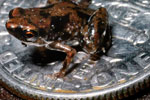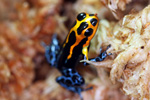Researchers have found that some frogs in Madagascar communicate by more than just sound and sight: they create distinct airborne pheromones, which are secreted chemicals used for communicating with others. A paper published in Angewandte Chemie International Edition relates that some male members of the Mantellinae family in Madagascar use large glands on their inner thighs to produce airborne pheromones. Interestingly, the pheromones are structurally similar to those produced by insects. Scientists have identified frogs producing water-borne pheromones before, but this is the first instance of airborne.
By looking at the glands of the species Mantidactylus multiplicatus researchers found that it produced two pheromones, or volatile compounds, one of which was similar to that produced by an Australian beetle. The pheromones, when mixed, attract other Mantidactylus multiplicatus.
“In fact, volatile compounds are widespread among the Mantellinae, but occur in species-specific mixtures,” says co-author Stefan Schulz with the Technical University of Braunschwe in a press release. “The volatile compounds could play a previously underrated role in species recognition over short distances in these very species-rich communities.”
In other words, the pheromones may help an individual identify another member of its own species in a diverse and crowded amphibian community, numbering over 100 species in the region. The pheromones likely make it less likely that two frogs from different species would attempt mating.
CITATION: Dennis Poth, Katharina C. Wollenberg, Miguel Vences, Stefan Schulz. Volatile Amphibian Pheromones: Macrolides of Mantellid Frogs From Madagascar. Angewandte Chemie International Edition. 2012. DOI: 10.1002/anie.201106592.
Related articles
New frog trumps miniscule fish for title of ‘world’s smallest vertebrate’

(01/12/2012) How small can you be and still have a spine? Scientists are continually surprised by the answer. Researchers have discovered a new species of frog in Papua New Guinea that is smaller than many insects and dwarfed by a dime. The frog trumps the previously known smallest vertebrate—a tiny fish—by nearly 1 millimeter.
(01/03/2012) The chytrid fungus, which is responsible for the collapse of numerous amphibian populations as well as the extinction of entire species, has been located for the first time in India, according to a paper in Herpetological Review. Researchers took swabs of frog in the genus Indirana in the Western Ghats and found the killer fungus known as chytridiomycosis.
The dark side of new species discovery

(12/21/2011) Scientists and the public usually rejoice when a new species is discovered. But biologist Bryan Stuart has learned the hard way that the discovery of new species, especially when that species is commercially valuable, has a dark side-one that could potentially wipe out the new species before protections can be put in place. Stuart has discovered 27 species unknown previously to scientists – so far. That includes 22 species of frogs, three types of snakes, and two salamanders. His experience with one of these, a warty salamander from Laos with striking markings (Laotriton laoensis), opened his eyes to a dark side of scientific discovery: commercial overexploitation before protections are in place. Shortly after Stuart described the previously unknown species Paramesotriton laoensis in a scientific paper published in 2002, commercial dealers began collecting this Lao newt for sale into the pet trade. In essence, the dealers used Stuart’s geographic description in the paper as a “roadmap” to find the rare newt.